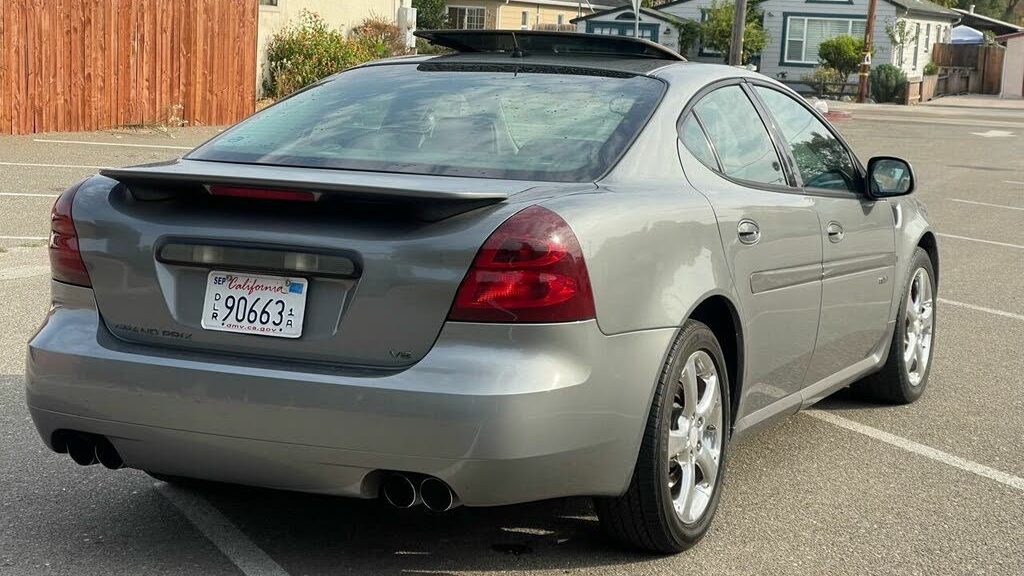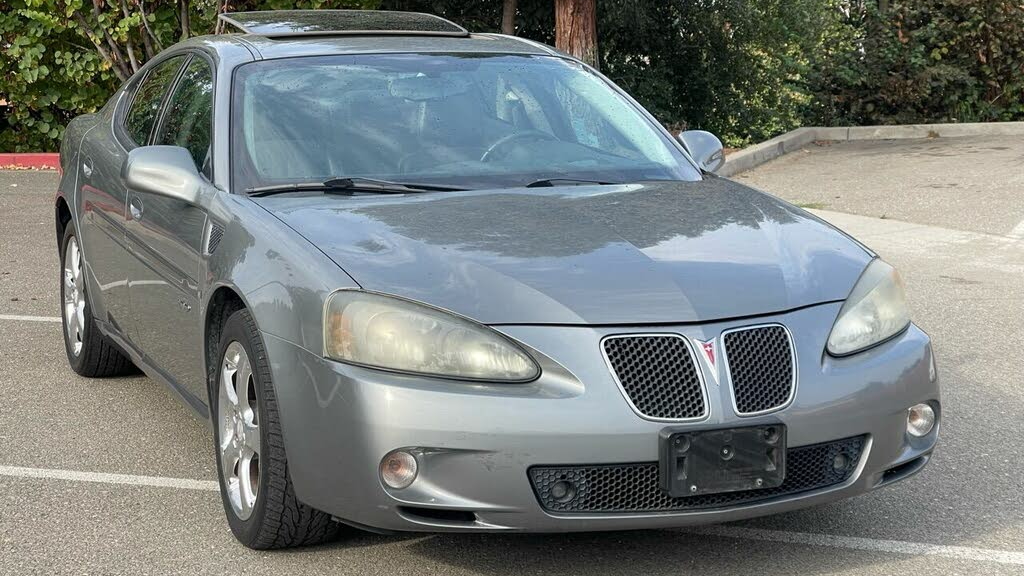When you think about weird cars, what do you picture? Perhaps a Citroen 2CV merrily skipping its way across a field, or an Innocenti 950 Spider touring up an Alp. Either way, it’s likely not a full-size front-wheel-drive American sedan with a rental-grade interior. However, there are exceptions to everything, and the Pontiac Grand Prix GXP was completely mad. A W-Body with a V8 made to chase European sports sedans shouldn’t exist, yet you used to be able to walk onto a Pontiac lot and buy one. Crazy, right? If you’re not convinced, just continue reading.
Welcome to weird spec, a recurring series where I go over some of the more mundane oddities of the automotive world. It’s easy to tick off great options on great cars, but those who tick off strange options on normal cars deserve credit too.

Throughout automotive history, there aren’t many cars with transverse V8s between the front tires. Outside of a single generation of Ford Taurus SHO and a handful of Volvos, you’re most likely to find this sort of layout in a GM product.
In the beginning, GM wanted to do something really different with the Oldsmobile Toronado and mated a 425 cubic-inch V8 to a transaxle for secure front-wheel-drive handling. however, despite the Toronado’s front-wheel-drive layout, its engine was still mounted longitudinally (there was a chain-drive involved; it was bizarre). As the years progressed, GM’s rationale for front-wheel-drive V8s was driven less by flagship appeal and more by practical considerations. American luxury car buyers wanted the smooth, effortless torque of a V8 and transverse front-wheel-drive platforms hold weight (and thus fuel economy) and packaging advantages over rear-wheel-drive platforms, so cars like the Cadillac Allante and Oldsmobile Aurora made sense. However, the tides were beginning to shift in the 2000s. Floating along on a two-ton waterbed was out, crisp European-inspired handling was in, and rear-wheel-drive was back. However, while Chrysler was kicking ass with the LX platform, GM looked at its history of transverse V8-engined cars and thought “how hard could it be to make this concept compete with the best sports sedans from Germany?”
Instead of the Northstar, GM ended up almost completely re-engineering its LS V8 to fit in transverse applications. Sure, the cylinder head castings were standard LS6 units, but almost everything else was new. The water pump was remote-mounted on a manifold that featured integrated idler pulleys, the crankshaft was shortened, the starter moved to be mounted on the gearbox, and the entire block was new. Seriously though, take a look at this crazy water pump manifold.

The result was a 5.3-liter V8 that made 303 horsepower, exactly three more than an L37 Northstar from 2004. That’s a lot of work for such a small result up top, but an extra 30 lb.-ft. of torque seems worth the hassle. The LS4 V8 also gained something familiar to Cadillac buyers of old – cylinder deactivation. The LS4 was the first LS-designated performance small-block V8 to feature cylinder deactivation, and GM still hadn’t worked out the kinks more than 20 years after Cadillac’s disastrous attempt at the tech. The LS4 suffered from lifter wear issues, although they typically wouldn’t appear until after another failure point made itself known.
Just like how Porsche had Tiptronic, Pontiac had a paddle-shift function of its own. Named Tap-shift, both the left and right paddles operate in the exact same way – push forward to upshift, pull back to downshift. The problem is, you only really have one upshift and one downshift in spirited driving because first gear goes to 56 mph and second goes to 105 mph. If drag and tires suddenly weren’t concerns, the tire diameter and gearing mean that the Grand Prix GXP’s fourth gear is theoretically good for 235 mph. I’m not making this up, it’s a 0.7:1 fourth gear with a 2.92:1 final drive and a 255/45R18 front tire.
Of course, that’s assuming the gearbox works. While GM had the 4T80-E in its arsenal, the MN7 4T65-E HD was called into duty here. The problem with that is the MN7’s torque capacity of 280 lb.-ft. is a smaller number than the 325 lb.-ft. the LS4 V8 can crank out. Oh dear. Here’s what GM LS4 superfan site LS4 Store has to say about this:
The “HD” stands for Heavy Duty. Otherwise, they’re based on GM’s 4T65E transmissions, but with some beefing up of various components. MN7s come from the factory with upgraded input and final drive sun gears, carrier assemblies, and upgraded drive sprocket thrust washers. Additionally, MN7 have modified cases for relocated starter mounts.4T65E-HD MN7s are rated from the factory at 280 ft-lbs of torque on the engine side, 400 ft-lbs of torque on the gearbox side. However, LS4s come from the factory rated at 325 ft-lbs of torque at the crank. Some have speculated that this may lead to long-term sustainability issues for stock transmissions. Unfortunately, there are hundreds of cases of transmission demise. My stock transmission — even with life-prolonging upgrades — broke down after 45,000 miles.
Still, when the gearbox was working, the Grand Prix GXP could sprint to 60 mph in under six seconds, not blistering by today’s standards but pretty damn quick for the mid-2000s.

So that’s power sorted, what about handling? Well, the problem with front-wheel-drive V8-powered cars is that they’re typically very front-heavy. At the back, you have a muffler, a fuel tank, and the rear suspension, while the front end bears the weight of an engine, a gearbox, axle shafts, suspension, the list goes on. Pontiac’s engineers were targeting BMW with the Grand Prix GXP, which is a bit like if Taco Bell said it was aiming for a Michelin star. I like Taco Bell, but it’s not on that level. Still, that didn’t stop Pontiac engineers from trying something very unusual to band-aid the handling balance.
Up front, the Grand Prix GXP got eight-inch-wide 18-inch wheels wrapped in 245/45R18 tires. Out back, it got seven-inch-wide 18-inch wheels wrapped in 225/50R18 tires. Basically, they looked at a Corvette’s rolling stock and thought “What if we did that in reverse?” A staggered tire setup typically consists of wider tires on the rear axle and narrower tires on the front axle because that promotes safe understeer on rear-wheel-drive platforms. As Pontiac tried out a reverse stagger, it had the reverse effect, neutralizing some understeer on a front-heavy platform.

The subtle lunacy continues inside the Grand Prix GXP, where a giant Campbell’s soup can-sized knob sits just to the right of the gear lever. Does it stiffen up suspension, change drive modes, or even adjust the level of active traction control? No, it controls the heads-up display, with the knob rotating through three levels of brightness. If you actually want to change the information on the HUD, you have to use the little rocker switch on top of the knob, although you don’t get much selection. Page one displays everything, page two displays everything save for compass and outside temperature, and page three turns off the gauge cluster lighting at night so you can just use the HUD. Granted, the HUD isn’t a GXP-exclusive feature, but you definitely won’t find it on a base model.

What you won’t find on any other 2005 Grand Prix is a G-meter. Built into the driver information center at the top of the dashboard, the G-meter displays peak acceleration, deceleration, and lateral g-forces, but only when the vehicle is stopped. What miserable lawyer imposed those conditions? In case you forget that you’re in a Grand Prix GXP, Pontiac gave it special bolstered sport seats and a unique instrument cluster with a font that’s actually legible, turned aluminum accents, and the GXP emblem on the 160 mph speedometer.
Another bit of strangeness worth noting despite being featured on every eighth-generation Grand Prix is the dashboard. Because Pontiac was GM’s excitement brand, the design team figured that the Grand Prix should get a driver-oriented center stack. Common equipment on cars like the BMW E46 3-Series, Oldsmobile Aurora, and Honda S2000, it often helps the driver but leaves the front passenger a little bit bored. The Honda S2000 and E46 3-Series gave their passengers pretty much nothing to play with, while the Aurora upped the ante with climate controls in the door. However, the Grand Prix offered not one, not two, but four air vents exclusively for the front passenger. There’s a well-known joke about how GM designs an air conditioning system and then builds a car around it, and the Grand Prix really seemed to lean into it.

What makes the special V8, the reverse-staggered tires, and the bizarre lawyer-nerfed g-meter even crazier is how ordinary the Grand Prix’s bones are. This thing’s still a W-Body, and it was the darling of rental car lots and company car fleets. The Grand Prix GXP is a bit like if Dodge dropped a V8 into the Stratus, or if Nissan dropped a V8 into the Altima.
The Pontiac Grand Prix GXP wasn’t the only car to get the LS4 engine, but it may have been the weirdest. Sure, the Impala SS was a bit more common and the Buick Lacrosse Super was more of a sleeper, but the glorious lunacy of the Grand Prix GXP is something to celebrate. It’s like a more mediocre version of a Hellcat, a gloriously excessive exercise in making a platform do something it was never meant to accomplish. I bet that Roger Smith never expected this platform to eventually pack more power than the 1987 Corvette, or the reverse stagger, or such ridiculous gearing. The Grand Prix GXP isn’t as good as something like an Infiniti M35 or a Lexus GS430, but it’s a hell of a lot more interesting than either.
Today, you can find Grand Prix GXPs for sale priced mostly between $5,000 and $8,000. That’s not bad value given the insane car market, especially considering what you’re getting. This one’s up for sale in California for a reasonable $5,900 with 138,000 miles on the clock. While sky-high gas prices and the likelihood of some mechanical issues mean a Grand Prix GXP probably isn’t the smartest buy on the market, it’s entertaining as hell. After all, shouldn’t cars be a bit of a laugh?

Oh, and since you made it to the end, I have a little something extra for you. Beneath the GXP in the Grand Prix lineup sat the GTP, a supercharged 3800 V6-powered model that made a great deal more sense than the nutty GXP. To advertise it, Pontiac hired Samuel L. Jackson, and there’s an outtake from his voiceover recording session circulating around the internet. Needless to say, you might not want to play this one out loud at work.
Lead photo credit: Seller


I owned an 06 GXP for 5 years. Bought it 2017 and just sold it this summer. It was my daily driver and it was a ton of fun to drive. The torque was insane. Never had it over 100mph. This car would beat just about any other similar car to the 60-foot line, and most of them past that. The scariest part of driving it was doing a hard accel from stop or slow roll. The torque would pull very hard to the right. You had to be ready and hang on tight to keep the front end under control, but what a thrill it was! I don’t know why you are calling it strange, quirky and whatever other adjectives you used. These cars are worthy of their value. I will admit, the tranny was probably the quirky part of the car. Mine slipped a little in first and second gears, but I installed a shift kit in it and it fixed that problem. This car would squeal the tires off the line and just about anytime you punched the gas while in motion. Like the 3800 Series II, the LS4 is a bulletproof motor. As long as you do regular maintenence(oil changes, etc.) it will run strong for a very long time. The DoD(displacement on demand) was good for highway driving, but not so much in the city. The gearing combined with in town speed limits would often cause it to go back and forth from 8 to 4 cylinders. All in all, these were great cars. They just weren’t meant for any Joe Blow, however. These were meant for people that were more car enthusists(gearheads, if you will). I enjoyed driving and doing regular maintenence on mine. Spark plugs, oil changes, air filter cleaning and oiling.
I’d take an LS4 over just about any V6 out there. V8’s just sound so much better.
When did these actually hit the streets? In February 2004, a coworker of mine insisted that he had a rental Grand Prix with a V-8 and I thought he was totally full of crap. I later learned that the V-8 became an option, so I was always wondering if it was actually available in February 2004.
I never got to drive a GXP but I have driven this gen Grand Prix and it was an awful car… the interior is an ergonomic disaster and considering the size of the car the cabin is so small… front headroom was bad (with the seat at its lowest my 5,10 frame still couldn’t find a comfortable position) and everyone getting in the rear doors would hit their head on the downward swooping roofline. Oh and the manufactured exhaust growl from the V6 was so tacky sounding.
I assure you that is just what a 3800 V6 sounds like. I find it a bit charming honestly.
Wow, reverse staggered wheels. Do any other cars do that?
I handful of models over the years have… the newest-gen Audi RS3 for example.
sigh… I = A
Around 2007 I was travelling to the Miami area and needed to rent a car for a couple days since the busses had stopped running from FLL to Miami. The guy at the rental counter offered me 3 options in the mid-size category: Ford Taurus, Nissan Altima, or Pontiac Grand Prix. Having owned a Taurus a couple times in this life, and not being a fan of Nissan, I chose the Grand Prix.
As I was walking to the car, I passed a few rows STOCKED with the then-new last-generation Mitsu Eclipse. I decided that I was going to head back in to see how much more expensive it would be to rent one of those. Being as close to my car as I was, and figuring I wouldn’t want to pony up the extra cash, I went to my car’s spot to stash my luggage so I wouldn’t have to cart it back and forth for nothing.
As I got close enough, I noticed this GP had some vents on the side, a tell-tale sign of the GXP models. Then I saw the GXP badge. I quickly threw my luggage in the trunk, opened the driver’s door and popped the hood. I had to look at the engine because I couldn’t believe they’d just have one of the hot-rod models listed in their system as a “Grand Prix” to be loaned out to any 25 year old that walked in the door. Hood raised, I saw the V8, got a shit eating grin on my face, and quickly headed down the road.
Those two days were glorious, I didn’t want to give it back. Getting back home to my 4.0L Grand Cherokee felt like I was thrown back into the stone age!
I remember these from the days of my youth. So crazy. My Dad had a 2004 Grand Prix GT (with the 3.8) as a rental car and I remember him doing a hard pull in that thing. It had plenty of pep. Thanks for bringing back some happy childhood memories!
I actually had the GXP as a rental when these cars were still new. At 25, I had never experienced this sort of power. It was a good couple days!
“…despite the Toronado’s front-wheel-drive layout, its engine was still mounted longitudinally (there was a chain-drive involved; it was bizarre).”
Not really, it worked well in practice and was quite reliable. The powertrain was even used the innovative GMC motorhome that Mercedes recently featured (which was much heavier than a Toronado). The TH425 was just a TH400 that was turned around for front drive applications with a HyVo chain transferring power from the torque converter to the transmission. Similar chains are commonly used in transfer cases on most 4×4 trucks these days.